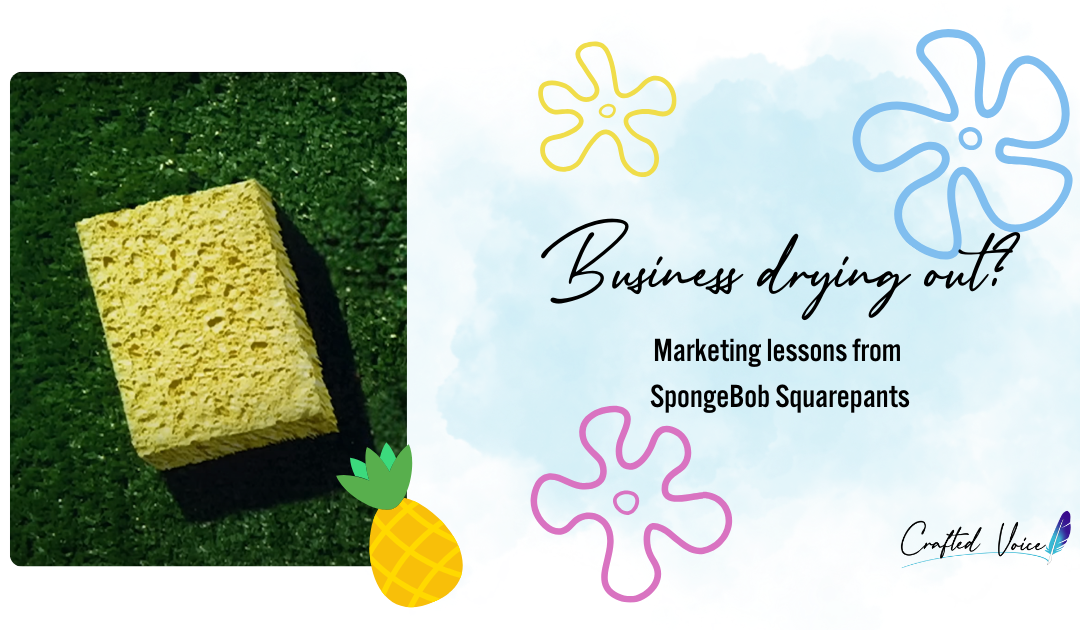Companies that venture into the world of marketing without the proper research and a well-thought out strategy are like SpongeBob Squarepants visiting his friend Sandy the Squirrel for the first time. [If you weren’t a kid in the early 2000s, stick with me – I promise this is GOLD!]
SpongeBob Squarepants is a cartoon sponge who lives under the sea with his friends in Bikini Bottom. At one point in the series, a land squirrel, Sandy, puts on an astronaut’s helmet filled with air and comes to live with them. One day, SpongeBob decides to visit her in her air-filled dome and quickly realizes the importance of water – the water that suddenly doesn’t have. He dries out quickly – panics and tries desperately to escape without Sandy knowing it. Without water, he won’t last long.
Marketing is like the water that a sea sponge needs to survive. Regardless of a business’ size or industry, it will wither up and be out of business quickly without marketing. Understanding and implementing effective marketing for business owners is the key to not drying out. Let’s explore a few best marketing strategies used by companies to guide you through creating a plan that keeps your business thriving.
What is a marketing strategy with example?
A marketing strategy is your game plan to reach your specific business goals through various marketing activities. For Spongebob, he went to visit Sandy, without any information or preparation before venturing into unknown territory. He didn’t know what he didn’t know, and it cost him dearly.
If you are reading this, it’s likely that you aren’t a marketer. You don’t know what you don’t know, but are trying to learn. You already have a leg up over SpongeBob!
The most important thing to know before marketing your business are the foundation elements of a good strategy. An example of an exceptional marketing strategy includes:
- Setting your Customer Personas as your North Star.
- Establishing Brand Voice Guidelines to serve as anchor language for all marketing messaging.
- Conducting thorough competitor analysis and target audience research to acknowledge your accurate position in the market, and locate your customers (so you know where to find them!).
- Charting Customer Journey Maps to pinpoint all customer touchpoints and messaging opportunities.
- Drafting an Editorial Calendar to put organization and flow between marketing campaigns.
From there, you can determine which marketing activities make sense for your business to invest in to achieve your goals.
For SpongeBob, he missed these critical steps. He didn’t do his research (air is bad, he needs water), he didn’t know his target audience (Sandy lives in air, not water), and he didn’t have prepared messaging that empowered him to tell Sandy what was going on. Once Sandy realized what was happening, she quickly found a solution – she put a fishbowl over his head and filled it with water. If SpongeBob would have done his research, he could have avoided a crisis by proactively implementing this solution before he visited.
Take a break and watch the scene unfold below – it’s a nostalgic goodie!
How do you determine a company’s marketing strategy?
Once you have laid the foundation for your marketing strategy, you can then decide what marketing activities make sense for your overall strategy. In other words, you know what to expect, but how can you prepare yourself to manage the world of marketing before you launch?
The components of marketing management to consider are:
- Product: This is what you’re selling.
- Price: This is how much you’re charging for your product or service.
- Place: This is where and how your customers can get your product or service.
- Promotion: This is all the stuff you do to get the word out about your product or service.
- People: This is all about the people who are involved in your business—both your customers and your employees.
Global marketing strategies often use a mix that incorporates each of these five Ps, with 2 leading the way as priority and the others making an impact in secondary ways. (Examples below) When it comes to small businesses, especially those that are local, this same strategy can work well on a smaller scale. Just remember that your target audience should serve as your north star and guide all of your marketing decisions. If your target audience is SpongeBob, stay away from marketing inside air-filled domes… he clearly does most of his hanging out in the water.
What are the 4 types of marketing strategies?
There are many more than 4 types of marketing strategies, but below are the most common strategies for small businesses. You can mix each of these strategies to tailor the perfect strategy to reach your target audience.
Content marketing involves creating and sharing valuable, relevant content (information and stories) to engage your target audience. It builds brand awareness, establishes credibility, and drives customer action through articles, videos, infographics, and more.
Social media marketing uses platforms like Facebook, Instagram, and LinkedIn to connect with your audience, build brand awareness, and drive traffic and sales. It involves creating and sharing posts, engaging with followers, running targeted ads, and analyzing performance metrics.
Affiliate marketing is a performance-based strategy where businesses reward affiliates for promoting their products and driving conversions. Affiliates earn a commission for each sale, lead, or click, incentivizing them to market the brand to their networks.
SEO (Search Engine Optimization) marketing improves a website’s visibility and ranking in search engine results. It includes keyword research, on-page and technical optimization, and link building to attract organic traffic and increase online visibility.
SMS marketing sends targeted text messages to customers to promote products, services, or events. It’s a direct communication channel for promotions, discounts, reminders, and personalized offers, ideal for customers who prefer texts over calls or emails.
What is an example of a company marketing strategy?
Many companies focus on a mix of the 5Ps (product, price, place, promotion, people) to make up their marketing mix.
One example from dozens of innovative marketing strategies comes to us from tech-power house Apple, who uses a combination of product differentiation (product) and customer engagement (people) as its core marketing strategies. They focus on innovation, sleek design, and a premium customer experience to set them apart from competitors. This approach not only attracts a loyal customer base but also establishes Apple as a leading brand in the tech industry.
Another notable example is Nike‘s “Just Do It” campaign. This strategy combines emotional branding with storytelling, creating a powerful connection with consumers. By featuring inspirational stories of athletes overcoming challenges, Nike not only promotes its products but also builds a strong brand identity focused on motivation and achievement.
Nike also leverages digital marketing activities, such as social media marketing and influencer partnerships, to reach a broader audience. This marketing mix ensures a consistent brand voice across all channels, reinforcing Nike’s position as a leader in sportswear and equipment.
Don’t Let Your Business Dry Up
Your business needs a marketing strategy that is built on the strong foundation of customer personas, brand voice guidelines, competitive analysis, and customer journey maps. Without this, you might dry up faster than SpongeBob inside Sandy’s air-filled home. The team at Crafted Voice Communications is available to help you establish these critical elements so your efforts are set up to support your business goals. Schedule a free consultation today.

